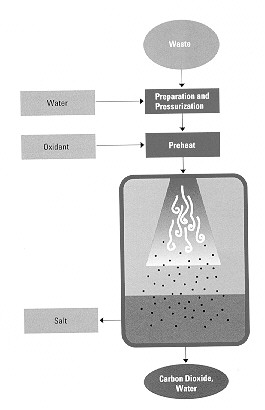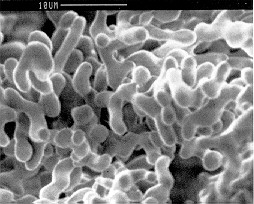Hazardous wastes are both legacies and current by-products of energy production and utilization. Most industries--including energy-intensive ones such as petroleum refining, bulk and fine chemicals manufacture, pharmaceuticals production, and metals recovery and processing--continue to produce significant quantities of organic and metals-containing wastes that must be destroyed or detoxified. Further, the need to destroy obsolete chemical weapons and to clean up the
US Department of Energy nuclear weapons complex present major challenges.
In the Energy Laboratory's program on Waste Remediation and Environmental Restoration, scientists and engineers are conducting fundamental and applied research on many facets of the waste destruction process. Work relating to waste prevention and air emission control appears in the sections on environmental research and industrial processing research.
Researchers are developing techniques and instruments for characterizing and
monitoring the chemical nature of the waste as well as the geotechnical nature
of the site. One focus is development of optical sensors for the remote monitoring
of mixed radioactive and organic wastes in soils. Work to analyze the toxicity
of the waste and to determine potential health hazard is performed in collaboration
with the Center for Environmental
Health Sciences.
Other research aims to understand the fate and transport of chemicals in the
environment, with a focus on characterizing the distribution and physical state
of the dispersed materials in groundwater and in soils. These efforts are led
by researchers from the Ralph
M. Parsons Laboratory for Water Resources and Hydrodynamics.
Various research teams are examining diverse technologies for treating key chemical and contaminated soils. Approaches under study include the molten metal processing of mixed radioactive and organic wastes; the molecular design, synthesis, and testing of star polymers for selective extraction of organic wastes; and the photocatalytic decomposition of halogenated organics using nanostructured titania. Studies of incineration involve fundamental work to increase efficiency and reduce emissions and applied work that has led to new methods of monitoring incinerator efficiency. Other research is investigating sub- and supercritical water oxidation as a promising and innovative technology for the efficient destruction of a wide range of industrial and military hazardous wastes.

Waste destruction by supercritical water oxidation (SCWO).
Another research area involves integrated modeling to match technologies to site-specific remediation problems. Topics include uncertainty and risk assessment, simulation of treatment processes and their economics, and development of methodologies for trade-off analysis and decisionmaking involving various stakeholders.
Selected Participants
- Janos M. Beér, Chemical Engineering: combustion; flame aerodynamics;
incinerator monitoring.
- Daniel Blankschtein, Chemical Engineering: micellar and colloid surface
chemistry.
- Robert E. Cohen, Chemical Engineering: star polymer synthesis and property
evaluation.
- Daniel R. Cohn, Plasma Fusion Center: plasma treatment of waste.
- David G. Cory, Nuclear Engineering: magnetic nuclear resonance imaging.
- Elisabeth M. Drake, Energy Laboratory: risk and trade-off analysis of waste remediation processes.
- Merton C. Flemings, Materials Science and Engineering: molten metal processing
of waste.
- Michael W. Golay, Nuclear Engineering: nuclear technology and waste processing.
- Peter Griffith, Mechanical Engineering: heat transfer; multi-phase flow.
- Kent F. Hansen, Nuclear Engineering: nuclear technology, safety, and waste
management.
- Jonathan G. Harris, Chemical Engineering: statistical mechanics; computer
simulation of complex molecular phenomena.
- T. Alan Hatton, Chemical Engineering: separations processes using star polymers
and micellar structures; colloid chemistry.
- Harold F. Hemond, Civil and Environmental Engineering: watershed chemistry;
field instrumentation; groundwater contamination.
- Howard J. Herzog, Energy Laboratory: computer simulation of chemical processes; mathematical modeling.
- Jack B. Howard, Chemical Engineering: combustion chemistry; solids pyrolysis;
kinetic modeling.
- Ronald M. Latanision, Materials Science and Engineering: corrosion science
and engineering.
- David H. Marks, Civil and Environmental Engineering: waste management; environmental
policy.
- William A. Peters, Energy Laboratory: thermal chemical processing; applied kinetics; heterogeneous reactions; thermal remediation of soil; hazardous waste destruction.
- Ronald F. Probstein, Mechanical Engineering: electroosmotic methods of remediation.
- Adel F. Sarofim, Chemical Engineering: combustion; aerosol physics and chemistry;
applied kinetics; radiative heat transmission.
- Kenneth A. Smith, Chemical Engineering: fluid mechanics; heat and mass transfer;
complex separations phenomena in supercritical water.
- Jefferson W. Tester, Energy Laboratory and Chemical Engineering: wet air
and supercritical water oxidation technology; chemical process engineering
and modeling.
- Malcolm A. Weiss, Energy Laboratory: analysis of US Department of Energy environmental management programs.
- Jackie Y. Ying, Chemical Engineering: nanomaterials; catalysis.

Sulfate salts collected during shock crystallization experiments in supercritical water.
Back to Current Research
Areas or
 the Energy
Laboratory Home Page.
the Energy
Laboratory Home Page.




 the Energy
Laboratory Home Page.
the Energy
Laboratory Home Page.